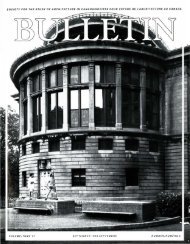CANADA - SEXTONdigital
CANADA - SEXTONdigital
CANADA - SEXTONdigital
You also want an ePaper? Increase the reach of your titles
YUMPU automatically turns print PDFs into web optimized ePapers that Google loves.
G AVIN S TAMP > ESSAY I ESSAI<br />
suspended in 1930 for economic reasons,<br />
Hobbs approached Lutyens instead (not<br />
for the first time did he cheerfully supplant<br />
another architect). 29 The memorial as built is<br />
one of Lutyens's last and most idiosyncratic<br />
executed works; in the flanking pavilions<br />
and the observation pavilion at the top<br />
of the tower he returned to themes that<br />
had exercised him early in his career,<br />
deconstructing Classical forms and<br />
making them hang, as it were, in space.<br />
Th is memorial was dedicated in 1938,<br />
completing the Commission's task.<br />
FIG . 19. MEN IN GATE AT YPRES, BELGIUM: REGINALD BLOMFIELD. I LANE BORSTAD.<br />
a correspondent for The Times considered the flags on the Cenotaph in London but<br />
that Forceville Community Cemetery Extension,<br />
planted with yew hedges and lindens was scarcely a new problem, but Lutyens<br />
was overruled. The design of a cemetery<br />
as well as flowers, was "The most perfect, demonstrated here that he was able to rise<br />
the noblest, the most classically beautiful<br />
memorial that any loving heart or any and developing the Classical language of<br />
to new heights of originality in abstracting<br />
proud nation cou ld desire to their heroes architecture to give dignity to these "silent<br />
fallen in a foreign land ... It is the simplest, cities of the dead".<br />
it is the grandest place I ever saw". 26<br />
Another impressive cemetery by Lutyens<br />
Lutyens, as Principal Architect, was responsible<br />
for designing or supervising 127 war Lutyens placed two exquisite lodges like<br />
is that at Villers - Bretonneux w here<br />
cemeteries in France and Belgium, although eighteenth-century garden pavilions at the<br />
many of these were actually the work of roadside entrance. From here, the ground<br />
his former assistant, Goldsmith. Lutyens rises in a gentle convex slope, past the<br />
himself was certainly personally respon Cross of Sacrifice standing between lines<br />
sible for some of the larger cemeteries, of headstones, to reach a wall covered in<br />
notably Etaples Military Cemetery near Le names either side of a look-out tower. This<br />
Touquet, next to the site of the notorious is the Australian National War Memorial,<br />
"Eat Apples" base camp - where a mutiny for it was here that Australian troops<br />
had occurred in 1917. Here, above stone re-<br />
checked General Ludendorff's offensive<br />
taining walls on rising land overlooking the towards Ami ens in 1918. Originally the<br />
railway from the Channel ports to Paris, he memorial was to have been the work of<br />
placed two extraordinary cenotaphs either the Australian architect, William Lucas,<br />
side of the Stone of Remembrance (fig. 13). who had won a competition in 1925, but<br />
Each of these pylons rises above an arched his design was disliked by Ware and by<br />
base and is flanked by stone flag s that General Talbot Hobbs, w ho had chosen the<br />
hang ever stil l - as he wanted to do w ith site for the memorial. When the project was<br />
Ware was distressed that the various constituent<br />
parts of the Empire chose to erect<br />
their own memorials as it undermined his<br />
vision of Imperial co-operation and also led<br />
to anomalies and the duplication of the<br />
names of the Missing in certain cases, but<br />
his persuasiveness- for once- was in vain.<br />
The Union of South Africa naturally turned<br />
to Baker for its memorial at Delville Wood,<br />
where hellish fighting had taken place during<br />
the Somme offensive. Baker was also<br />
responsible for the Indian Memorial at<br />
Neuve Chapelle, one of his happiest works<br />
in which the Moghul, Hindu and Buddhist<br />
elements used at New Delhi were combined<br />
in a beautiful circu lar enclosure (fig. 14). New<br />
Zealand chose to build several memorials to<br />
its missing in different cemeteries. That at<br />
Grevillers is by Lutyens; the one at Caterpillar<br />
Valley by Baker; and those in Belgium,<br />
at Polygon Wood and Messines, were designed<br />
by Holden in his severe neoclassical<br />
style. Canada, of course, chose not to use<br />
one of the Commission's own architects,<br />
but selected the sculptor Walter Seymour<br />
Allward (as discussed by Lane Borstad and<br />
Jacqueline Hucker in their articles).<br />
It is instructive to compare the British war<br />
cemeteries w ith those of the other fighting<br />
powers. The French chose to concentrate<br />
their dead in large cemeteries, with the<br />
bones of the many unidentified casualties<br />
put into ossuaries, as at Douamont near<br />
16<br />
JSSAC I JStAC 33 > N" 1 > 2008
















